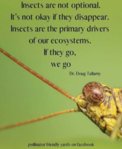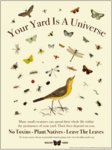



Especially this spring, after what feels like an endless winter with February weather in March, most gardeners are understandably impatient for the snow to melt and clear the way for yard work. But wait! If you feel you must clean up, hold off until pollinators that overwintered in your garden or yard can emerge.
Minnesota pollinator expert and author Heather Holm explains that raking leaves out of gardens and cutting plant stalks too early can leave pollinators out in the cold and vulnerable to spring snowfalls and frosts. For the sake of those pollinators, each spring the Xerces Society begs gardeners and homeowners to press pause and find ways to occupy our weekends with activities other than yard work. “If there is still a chance for snow and frost, your invertebrate neighbors still need cold weather shelter,” they point out. And we humans need these creatures for a healthy yard and environment.
The right timing of outdoor maintenance tasks is specific to our ecoregion and our yard, as well as our goals. If we want to help wildlife and support ecosystem function, choosing to delay and minimize spring yard work is essential. Cleaning up at the expense of pollinators reduces the environmental value and health of our gardens and yards, at a time when insects, birds and other wildlife need our help more than ever to sustain biodiversity.
50 degrees is just a starting point
According to experts, there’s no hard and fast date or temperature when it’s fine to disturb your yard from its winter rest. The Xerces Society suggests we wait at least until we’ve put away our snow shovels and winter coats, mowed the lawn’s new growth, and planted tomatoes. To protect pollinators that emerge later than most, they suggest waiting until apple and other fruit trees are done blooming.
Another option is to relocate leaf and plant debris to a corner of the yard for another week or two before removing it from the yard. Better yet, leave that debris corner alone, allowing beneficial soil fungi and bacteria to improve soil health and create a supply of free mulch. (But wait to mulch in spring until the soil has warmed sufficiently; otherwise mulch can slow the reawakening of plant roots and inhibit plant growth.)
A common message circulating these days is to wait until temperatures reach 50 degrees for at least five consecutive days before moving leaves or cutting down dead plant material. But this message, while helpful in reminding people to give insects a chance to leave their overwintering spaces, is oversimplified. Author and garden designer Benjamin Vogt disputes what he calls misinformation about the 50 degree guidance, because various insects “wake up” at different times throughout the growing season, with some not emerging until late summer. The original 50 degrees advice might have referred to soil temperature, a cue for spring planting.
Maintain with Nature in mind
Vogt writes: “We’re still definitely stuck in this traditional, mow-and-blow maintenance idea that specific actions must occur at specific times of year and be performed in specific ways; that’s not gardening with nature, but against it. How we manage for best ecosystem functions … will be different season to season and year to year as we evolve in response to what the landscape is telling us.”
Holm also explains, “We need some new messaging to counter the ‘cleaning up the garden’ recommendations. Leave the leaves is good, but people still want to remove leaves in the spring. … Mother Nature does not remove leaves from natural habitats. Why would we not mimic natural patterns and processes in our gardens? It can only benefit all the invertebrates, plants, and other organisms that rely on leaf litter.” Until those cold May days are over, it’s likely that bees and other pollinators are still sheltering under leaf litter until they are ready to depart.
To calm worries that plants won’t be able to grow through a thick layer of leaves, Holm reminds us that leaf litter insulates plant roots, prevents the soil from drying out, suppresses weeds and weed seed germination, and most importantly, provides a place for many different types of beneficial insects – including bees, moths, fireflies, ladybird beetles and others – to complete one part of their life cycle.
“I often receive emails from people asking me when it’s ‘okay’ to clean up their garden in the spring. The answer is don’t clean up your garden,” said Holm.
Comments
No comments on this item Please log in to comment by clicking here